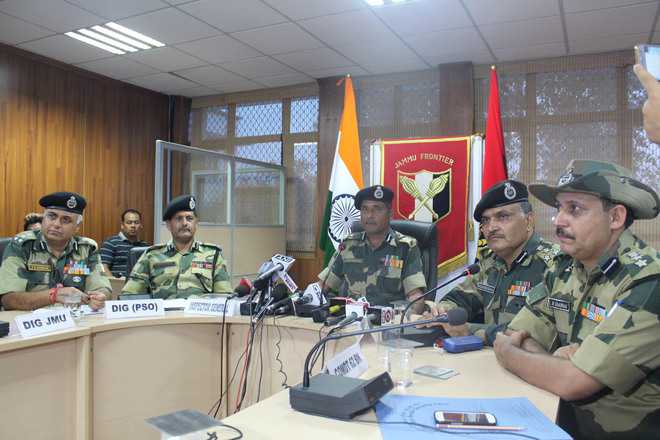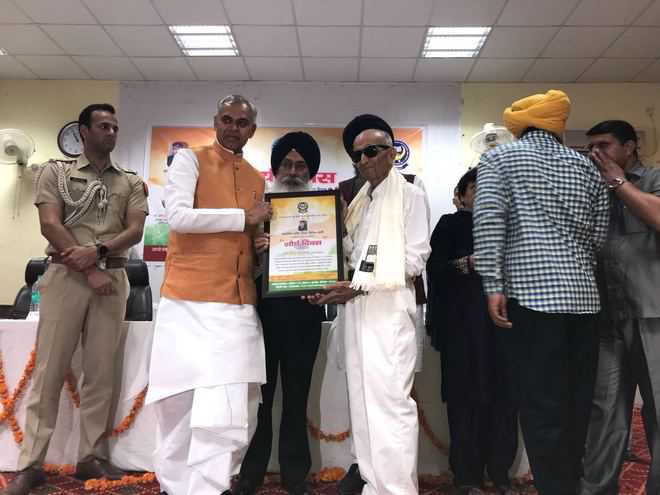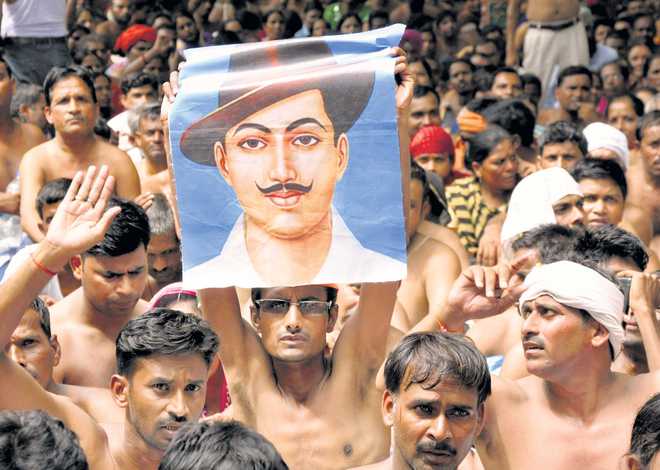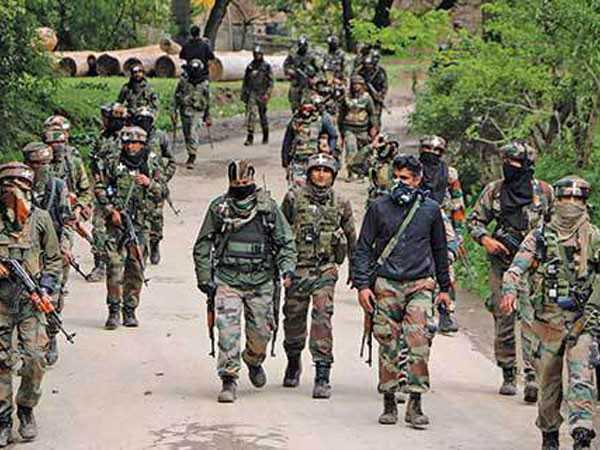






Recently, India branded Pakistan “Terroristan”. External affairs minister Sushma Swaraj told the United Nations that Pakistan, as the world’s “pre-eminent terror export factory”, has just one national accomplishment to boast of. Yet New Delhi is loath to back its words with even modest action, such as downsizing Pakistan’s bloated, Inter Services Intelligence (ISI)-infested high commission in New Delhi, withdrawing the unilaterally granted Most Favoured Nation status, leveraging the Indus Waters Treaty (IWT), or halting the barter trade across the Line of Control (LoC) that the National Investigation Agency (NIA) has identified as financing terrorism.
Despite playing to the gallery at home, India has done nothing to treat Pakistan as a terrorist nation. Indeed, behind its rhetoric, India pursues a cautious approach. Successive governments have shied away from slapping sanctions of any kind on Pakistan, yet not been coy to press other powers and the United Nations for sanctions.
India seems reluctant not just to back words with action but also to back words with just words on some issues. Take Balochistan, Pakistan’s Achilles heel which is becoming the new East Pakistan because of military killings and mass graves. When Prime Minister Narendra Modi raised Balochistan in his Independence Day speech in 2016, it seemed to signal an important policy shift. Yet India has remained conspicuously silent on the Balochistan issue. Even as Pakistan uses fake photographs to peddle a false narrative on Jammu and Kashmir (J&K), India is unwilling to spotlight the brutal Pakistani campaign against the Baloch people.
Another example is India’s rhetorical stance that the only outstanding issue on J&K relates to the part occupied by Pakistan. Other than slamming China’s One Belt, One Road (OBOR) initiative for infringing its sovereignty, India has said precious little to show that it is serious about its claim to that occupied region. It has actually kept quiet on matters of substance, including China’s new dam and other strategic projects in Pakistan-held J&K. Had China been in India’s place, it would have raised a hue and cry over each and every project.
As for lack of Indian action, look no further than the IWT issue. Modi vowed that “blood and water cannot flow together”. But instead of action, what has followed is visible backsliding — from reviving the suspended Permanent Indus Commission to allowing the partisan World Bank to insert itself as a mediator between India and Pakistan. The IWT grants the World Bank no mediatory role. Such mediation, besides setting a dangerous precedent, breaches India’s traditional policy of not allowing a third party to intercede in bilateral disputes. Worse still, the Modi-appointed committee of secretaries on the Indus waters has fallen by the wayside, with not a single new project launched.
On the issue of cross-border terrorism, Modi, after the deadly attacks that followed his surprise Lahore visit, sought to salvage his credibility by launching a cross-LoC surgical strike on militant launch pads. But it was always clear that such a limited, one-off operation by itself would not be able to tame Pakistan. The surgical strike was followed by a terror attack on yet another military base. India must mount sustained pressure to keep Pakistan off balance and deny it room to pursue its strategy of seeking to inflict death by a thousand cuts.
The battle against Pakistan’s State terrorism is India’s fight alone. Why would the United States designate Pakistan a terrorist State when the main victim of Pakistan-scripted terror, India, is reluctant to impose any sanctions on its scofflaw neighbour? Indeed, the NDA government persuaded Rajeev Chandrasekhar to withdraw his private member’s bill in Rajya Sabha for declaring Pakistan a terrorism sponsor. New Delhi is even unwilling to declare the rogue ISI a terrorist organisation. Actually, in a stunning display of naiveté, India hosted an ISI-linked Pakistani team at Pathankot so that it could probe the attack ISI orchestrated there.
The plain fact is that India is all talk when it comes to imposing costs on “Terroristan” next door. India is not the UN that can remain content with all talk and no action.

GUWAHATI:A retired army officer was asked to prove his Indian nationality as Assam police branded him a Bangladeshi, an action that reflects the long and contentious conflict over illegal immigrants in the northeastern state.

A foreigners tribunal served a notice to Mohammed Azmal Hoque, who retired as a junior commissioned officer (JCO) last year after serving the army for 30 years.
The Guwahati-based Hoque maintains that his family is indigenous Assamese and his father’s name is mentioned on the voters list of 1966. His mother’s name was listed in the 1951 national register of citizens.
“I’ve no doubt that I will get justice. But it pains me when my daughter questions me if this is how the country treats those who serve it for so many years,” he said on Sunday.
Hoque enlisted in 1986 in a non-combat role technician and retired from the corps of electronics and mechanical engineers (EME) as subedar. He served at frontiers in Punjab and Arunachal Pradesh.
His wife, Mamtaj Begum, was summoned by a tribunal in 2012. She was cleared.
The couple son is studying in the Rashtriya Indian Military College in Dehradun and daughter at Army Public School in Guwahati.
“This incident has saddened me a lot. Even after 30 years of service to the nation, we are asked to prove our identity. This is unnecessary harassment,” he said.
The tribunal had served notices to government officials before and a talked-about instance is Assam police constable Abu Taher Ahmed, who was accused of being an illegal immigrant.

Amir Karim Tantray
Tribune News Service
Jammu, September 30
Alert Border Security Force (BSF) personnel today detected a 14-foot cross-border tunnel in the Arnia sector along the International Border. They also recovered ammunition, eatables and other ‘war-like’ stores from the spot.The tunnel was detected near the Mukesh border outpost this morning when the area domination party was sanitising the area.Addressing a press conference, Inspector General (IG) of the BSF, Jammu frontier, Ramawtar said after seeing suspicious movement 10-12 armed Pakistani nationals near the Dhamala nullah on the Pakistani side, the area domination party surveyed the area and detected the tunnel. “The BSF party taking all risk in a thick forest area, having a number of unexploded mortar bombs fired from Pakistan, reached close to the area. On observing the BSF party, the Pakistani nationals ran away, leaving their huge ‘war-like’ stores. The BSF began a detailed search in the area and found an unfinished tunnel which is about 12-14 feet long and approximately three feet in height,” the IG said. Charging Pakistan Rangers with backstabbing, he said, “On their invite, we held a flag meeting on Friday only and today the tunnel was detected. We remain alert and it was due to our alacrity that the tunnel was found,” Ramawtar added. The IG said the recovery of digging tools and freshly dug earth in the area indicated that the tunnelling had started recently with an intent to infiltrate terrorists across the border. He said regular inputs regarding the movement of anti-national elements across the border had kept the force on a highest alert.During the search operation, the BSF recovered two AK 47 magazines, one hand grenade, 7.62 ammunition, one magazine pouch, three head lamps, compass, three haver sacks, three forest hats, four sleeping bags, six digging tools, six wooden planks and eatables among other things.
Dineshwar Sharma heads to Kashmir for ‘sustained dialogue’ amid intense anti-militancy ops. Sharma’s task as Modi’s point person is daunting, yet it evokes new hopes. Honesty of purpose will define his success


Azhar Qadri in Srinagar & Amir Karim Tantray in JammuIn politics silence can imperil reconciliation and pull governments further away from people. In Kashmir, the pause has been allowed to continue far too long, eclipsing a wide shade of opinion with a cloak of secrecy and dangerous procrastination. The Modi government’s surprise appointment of former Intelligence Bureau chief, Dineshwar Sharma, as its representative for “sustained dialogue” can rekindle openness and honesty of purpose, provided there are no traditional ifs and buts. In a departure from their habit and tradition, Kashmiri separatists have chosen not to comment, issue a statement, or in more straight words, reject the initiative.The task assigned to Sharma, whose rendezvous with Kashmir began in 1992 when he was first sent to the region — then home to uncontrollable insurgency — as an assistant director of Intelligence Bureau, is different and more challenging than his previous works.His new task as the “representative” of the Modi government is complex as radical street sentiment and militant voices are overshadowing the political spectrum within the maze of separatist structure. It is a mission which many governments in the past have failed to accomplish. The factors have been relations between India and Pakistan, a volatile regional balance, a hardline opposition at home, and also the lack of will to get the things moving.Noor Mohammad Baba, a former professor of political science, says Sharma’s appointment is indicative of New Delhi’s willingness to go beyond security measures. “There is admission in New Delhi that only security measures haven’t helped them and there is a need for going beyond that,” he said.A good half-start for Sharma’s mission is the positive pro-dialogue signals that have emerged so far from the separatist camp. The significant messaging came in a corrigendum from a faction of separatist amalgam headed by Syed Ali Geelani on June 10. It regretted inclusion of “tripartite talks” as a translation error, which reduced the core part of previous day’s statement to “negotiations are the only option.”When Union Home Minister Rajnath Singh announced Sharma’s appointment, he left substantial hints that the process has not been initiated out of nothing. He made references to his own visits to Kashmir, including the one in September which lasted four days, and to Prime Minister Narendra Modi’s August 15 speech that talked about “hugging the people of Kashmir.”The talk of possibility of talks between the Centre and separatists, and also with Islamabad, had first surfaced in spring of 2015 when Syed Ali Geelani returned from New Delhi to a welcome rally at home. The state’s PDP-BJP alliance government, then headed by Mufti Mohammad Sayeed, had allowed it. It was a first major separatist rally in Srinagar in almost half a decade and had coincided with the brief release of Masarat Alam, a firebrand deputy of Geelani.In the midst of a major standoff between Geelani and a splinter militant group based in north Kashmir later that year, a new and surprise formation of separatist conglomerate came into being which named itself the Joint Resistance Leadership — headed by a separatist troika.The fate of Sharma’s Kashmir mission effectively depends on the Joint Resistance Leadership, a conglomerate of Mirwaiz Umar Farooq, Yasin Malik and Geelani. It is these three separatists who have been consistently calling for dialogue. In their joint statement on September 15 — the troika was allowed to meet for the first time in nine month — they had said that “they were never against” a sincere, meaningful and result-oriented dialogue process among the three parties to the dispute. “(We see) it as a means of conflict resolution,” they said.Even as New Delhi was working on an option of dialogue during the past months, it adopted the carrot-and-stick approach by launching a major counter-insurgency operation and also ordering a crackdown on mid-rungs of separatist structure by authorizing the National Investigation Agency to probe terror financing. The investigation has effectively kept the mobilisers within separatist group out of circulation and rendered the top leaders ineffective and vulnerable.The interlocutor will also have to make a careful balancing act as he talks to various stakeholders of clashing and competing ideologies. In plains of Jammu division, where the mostly Hindu population favours a complete merger with the Union of India and wants thecontentious Article 370 to be removed, the sentiments clash with the dominant idea in Kashmir.
Thrice in 17 yearsBefore appointment of Dineshwar Sharma, thrice such a step was taken by New Delhi, aimed at addressing the K-issue.KC Pant, the first interlocutor (2001-2002)An MP for 26 years, he was appointed interlocutor by Prime Minister Atal Behari Vajpayee to break the ice in the Valley. Pant faced difficult times as none from the separatist group agreed to talk. Shabir Ahmed Shah, who was not associated with Hurriyat then, met the New Delhi’s point man. The process was shelved because of Hurriyat’s cold shoulder.NN Vohra, second interlocutor (2003-2008)A former bureaucrat, who is currently J&K Governor, was appointed by the Vajpayee-led govt in February 2003 with the aim to bring separatists on board, which he successfully did. The then deputy PM, LK Advani, held talks with moderate faction of Hurriyat led by Mirwaiz Umar Farooq but the same were stalled by Pakistan and their proxies. Vohra’s five-year stint as J&K interlocutor till June 25, 2008, when he was given the new role as J&K Governor to stabilize the state during difficult times of Amarnath land row, was the most effective term. Dilip Padgoankar-led three-member team (2010-2011)Former journalist Dilip Padgoankar led a three-member team at the instance of Manmohan Singh-led UPA-II government in October 2010. Academician Radha Kumar and former information commissioner MM Ansari were other two members. They were appointed after Kashmir valley saw street protests during 2010 summer when few youths were killed in a fake encounter in the Machil area of Kupwara district. Separatists didn’t talk to them but they were able to compile a report, which was then submitted to the Centre. What happened to that report is still unknown.

Acharya Dev Vrat, Governor of Himachal Pradesh, on Friday paid tributes to Major Nitin Bali, who was martyred in Kargil in 2002The Governor said at a function organised in the city that the youth should be made aware of the supreme sacrifices made by armed forcesHe said society remains indebted to the families who send their wards to defence forcesThe Governor said Major Bali laid down his life while performing his duty in the most challenging hoursMartyr’s mother Dr Adarsh Bali and other persons from Kurukshetra and Karnal were honoured for their social activities. Kurukshetra, TNS
Located a stroll away from the Parliament, Jantar Mantar is the most convenient platform for both the ruling party and the Opposition to feel the pulse of the nation. To ban it for dissenters, on the plea of noise pollution, is not a wise move.

Brig Gurinder Singh & Col Dilbag DabasWE have all heard the story of Emperor Jahangir’s Bell of Justice (Adl-e-Jahangir). Anyone who felt aggrieved, could seek justice by ringing the bell. It is said that the gravity of the crime was indicated by the number of times the bell was struck and, accordingly, the executive appointed a munsif (judge) to adjudicate the matter. Importantly, the bell was so located where the Emperor and his council could also hear its sound in the court.Everyone loves the stories of justice-loving kings, be it 16th century Jahangir or the first century BC King Vikramaditya who often went in disguise to get first-hand information about his praja (public). The bedrock of justice is the availability of opportunity to the distressed to be heard. The strength of governance of an organisation or a nation lies in the robustness of its grievance redress system.
Jantar Mantar
In 1993, the government banned agitations at the Boat Club. Since then, Jantar Mantar, not far from the seat of power in New Delhi, has been the most preferred location for such protests. Every day, this place is thronged by angry Indians, aggrieved Indians, wronged Indians, marginalised Indians, exploited Indians, Indians considered children of a lesser God — young and old, individuals and groups, political and apolitical. They vent their ire and express dissent, on certain state policies which they feel need correction.The actual protest site is approximately 350-metre long stretch of Jantar Mantar Road connecting Ashok Road with Tolstoy Marg. There is no residential complex beyond Kerala House. The historic solar observatory, known also as Jantar Mantar, which stands astride Sansad Marg, has been a mute witness to the everyday celebration of our thriving democracy. For almost a quarter century, this road has showcased protests of government employees, tribals, farmers, traders, homebuyers, military veterans, and followers of different babas/swamis. And there are also demonstrations sponsored by political parties, both in favour and against the government of the day, which are usually marked by uniformity of banners and placards, party colour scarves/caps and elaborate arrangements of food packages for the participants brought in buses. The number of protesters goes up during the weekends and especially when the Parliament is in session.A walk in this area brings you face to face with diversity of our society; a mini Bharat as well as a mini India. Unlike elsewhere in the country, despite animated speeches and sloganeering by the protesters, the demonstrations at Jantar Mantar remain within the restrictions of time and space laid down by the Delhi Police. By the evening, the place is quiet, except for a few small groups huddled together.
Democracy & dissent
Democracy is the most acceptable form of governance because it gives a citizen the right to dissent without being victimised. It is meant to be a living form of the government which listens to alternative opinions, reasons them out and often embraces them. Disagreement is important to bring about a change for the better. In fact, democracy and dissent go hand in hand.The Anna Hazare and India Against Corruption protest for ‘Jan Lokpal Bill’ at Jantar Mantar in 2011 has been the most iconic in recent times. It catapulted the BJP to be a contender to grab power from the UPA and mid-wifed the birth of the Aam Aadmi Party (AAP). Propelled by these dissensions at Jantar Mantar, both the BJP and AAP came to power through peaceful elections, a hallmark of our democracy.Protests at Jantar Mantar in the wake of the Nirbhaya case in 2012 led to a revision of laws related to crime against women.
Failing Opposition
The Opposition’s main role in a democracy is to question the government and hold it accountable to the public and uphold the best interests of the people. In a parliamentary democracy, the Opposition parties must act steadfastly on behalf of common masses fighting for their common interest and grievances. However, recently , the Opposition has largely abdicated its responsibility of fighting for the public’s demands. Located a stroll away from the Parliament, Jantar Mantar is the most convenient platform for both the government and Opposition to feel the nation’s pulse.
Noise pollution
Now a munsif in the form of National Green Tribunal (NGT) has struck down the bell of Adl-e-Jahagiri on the premise that it makes sound, which is not good for the health of the public. As many as 24 years after this place became the venue for dissent, it has now been discovered that the noise emanating from Jantar Mantar pollutes the capital city the most and it may become music if shifted to the Ram Lila Ground or elsewhere. It is ironical that the judiciary has decried to shift the dissenters’ spot to a place where the noises cease to pollute the capital’s environs. Long ago, elebrated Urdu poet Faiz Ahmad ‘Faiz’ described such situation as, “Baneyhain ahel-e-hawas muddai bhi, munsif bhi; Kise wakil karen, kis se munsifi chahen?” (Facing those power crazed that both prosecute and judge, wonder, to whom does one turn for protection, from whom does one expect justice?).In four weeks from now, you may not see the aggrieved farmers from Tamil Nadu, defence veterans, environmentalists, religious groups, students, government/private employees and others at Jantar Mantar. Because the agitators are condemned out of the audible range of power-that-be, as this noise contamination is dangerous. One may argue that the right to speech is still not under threat.But New Delhi’s age-old tryst with dissent may finally be chocked, allegedly by its own noise pollution. The government of the day will undoubtedly be doing itself a disservice if it does not listen to Kabir, the legendary15th century mystic poet and saint from Banaras who said, “Nindakniyare rakhiye aangan kutich hawaye; Bin sabun pani bin anirmal karat subhaye.” (Keep your critic close to you; give him shelter in your courtyard. Without soap and water he cleanses your character). But how will you listen to dissent if it is banished from earshot?

Bathinda, October 12
The Indian Army is built on the foundation of discipline, esprit de corps, courage and adventure. It has always been at the forefront of adventure-related activities.With this view, South Western Command Army Aviation is conducting a cycling expedition from Bathinda to Jhansi via Jaipur. The expedition was flagged off by Lieutenant General PC Thimmaya, General Officer Commanding of Chetak Corps, on Monday.The expedition, comprising Capt HS Tomer, one Junior Commissioned Officer and five jawans, will cover 900 km traversing through the states of Punjab, Haryana, Rajasthan, MP and Uttar Pradesh. The expedition will finally culminate at Jhansi on October 18.The team of Army aviation, the largest operator of helicopters in the Indian Army, will carry the message of safety and security to citizens. The members of the team will utilize this opportunity to interact with local populace, especially students of various educational institutes along the way.They will extend an open arm invitation to all adventure lovers into the folds of Indian Army. The expedition team aims to motivate the youth to join the Army and pursue adventure activity and excellence in profession. The Army hopes to reach out to people through this adventure activity to foster the spirit of adventure, camaraderie, patriotism and the will to serve the country. — TNS

Two militants were also killed in the operation.
Tribune News Service
Srinagar, October 11
Two IAF personnel were killed in a gunfight with militants in Bandipora district of Jammu and Kashmir on Wednesday, an army official said.The IAF personnel were part of the operation for training.
(Follow The Tribune on Facebook; and Twitter @thetribunechd)
Two militants were also killed in the operation in Hajin area of Bandipora, the official said.He said the two Indian Air Force Garud personnel who were injured in the gunfight with militants later succumbed to their injuries.The operation was going on reports last came in, he added. With PTI






















































